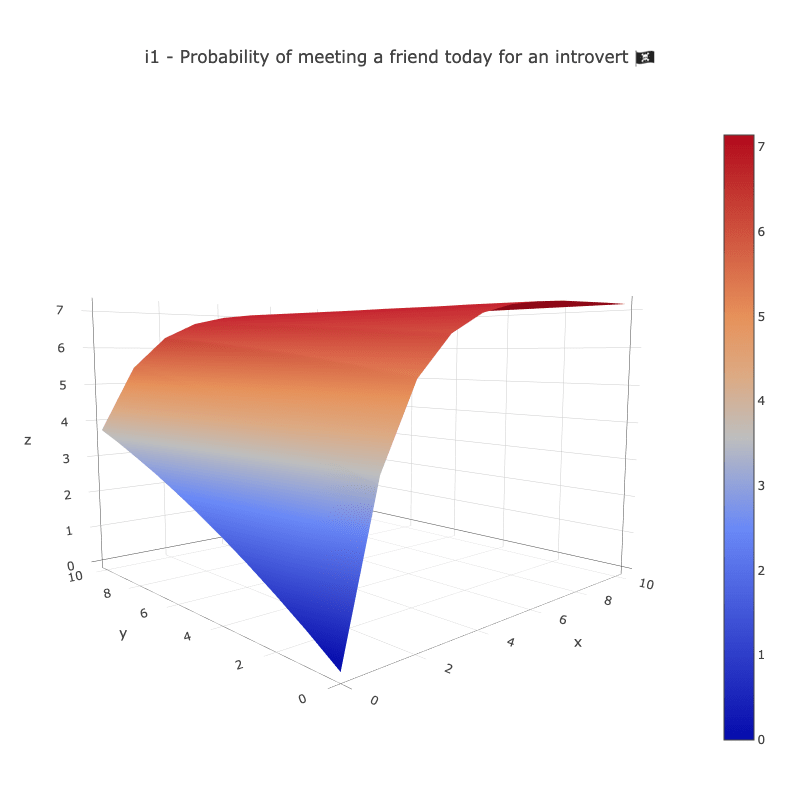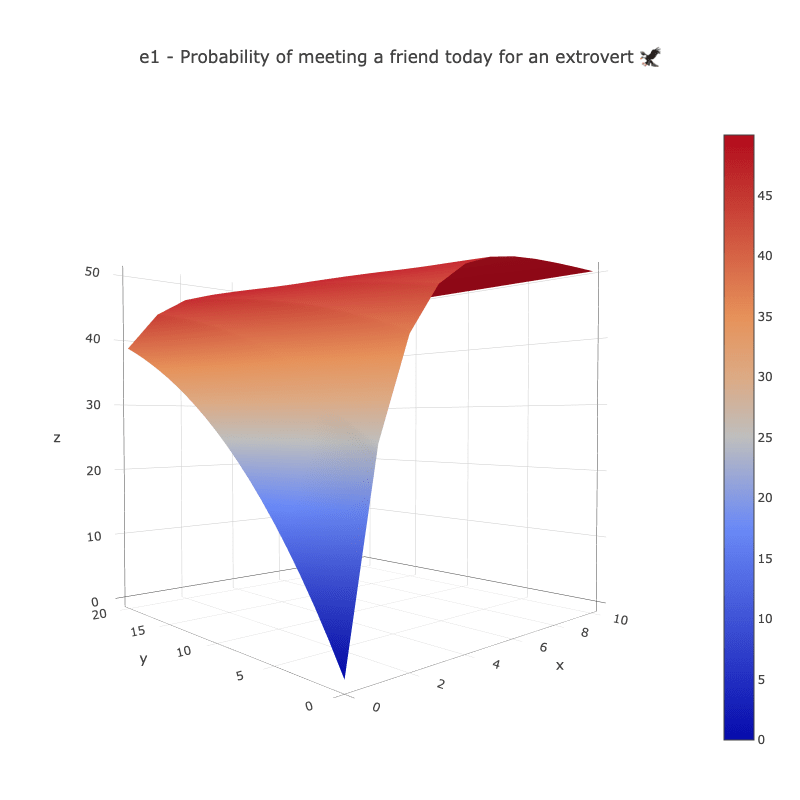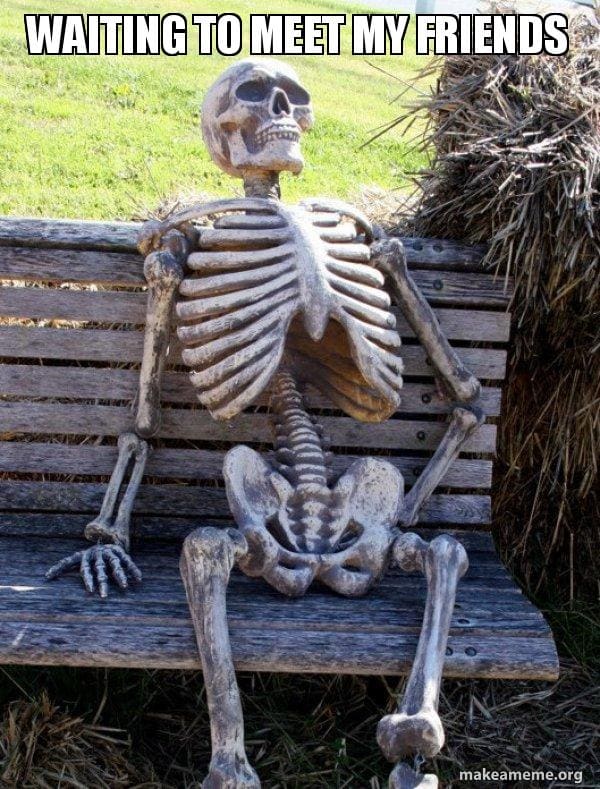Who Feels More Alone?
post by marvinscheffold · 2024-09-22T11:54:06.324Z · LW · GW · 2 commentsContents
Are You Going To Meet a Friend Today? In X Days You Will Meet a Friend (i) / (e) 0 1 2 3 4 5 6 7 8 9 10 0 1 2 3 4 5 6 7 8 9 10 11 12 13 14 15 16 17 18 19 20 (i) / (e) 0 1 2 3 4 5 6 7 8 9 10 0 1 2 3 4 5 6 7 8 9 10 11 12 13 14 15 16 17 18 19 20 How Pissed Off Is Ben? The “How Alone Do You Feel” Factor (i) / (e) 0 1 2 3 4 5 6 7 8 9 10 0 1 2 3 4 5 6 7 8 9 10 11 12 13 14 15 16 17 18 19 20 (i) / (e) 0 1 2 3 4 5 6 7 8 9 10 0 1 2 3 4 5 6 7 8 9 10 11 12 13 14 15 16 17 18 19 20 Are You Satisfied? Friends 🏴☠️ Introvert 🦅Extrovert 1 2 3 4 5 6 7 8 9 10 Introverts Feel More Alone Friends 🏴☠️ Introvert 🦅Extrovert 1 2 3 4 5 6 7 8 9 10 Conclusion None 2 comments
Imagine you live in a world with only two types of people. Introverts and extroverts. All introverts are the same. And so are all extroverts. It's a world with only two colors, and no shades in between.
Introverts like to be alone, in our world they want to meet a friend every 14 days. Extroverts love to be around other people. In our experiment they want to hang out with a friend every 2 days.
I´s and e´s also have something in common. They have short term memory loss. Everyday at midnight their brain does a full reset. So they never remember what happened yesterday.
Now that you know the basics of our thought experiment, take a guess: Which personality type feels more alone? Introverts or extroverts?
What does this question even mean? Let's say I'm an introvert. I wake up one morning and want to meet a friend. But when I call my friends, they don’t want to hang out with me.
That day I will go to bed feeling alone. But as I said above, the next morning will be a fresh start.
Here's two more ways to ask the same question. Who, on average, feels alone on more days, i’s or e’s? Whose interpersonal needs are being met less, i´s or e´s?
Did you take a guess? Maybe you picked e’s 🦅. Because they need more human interaction in general. Or you picked i’s 🏴☠️. Because they shoot themselves in the foot by being such loners?
Let’s take a closer look at our protagonists:
| Introvert | Nickname: i as in ay ay, captain 🏴☠️ | |||||
| Wants to meet a friend once every | 14 | days | ||||
| Probability wants to meet a friend today | 7.14% | |||||
| Extrovert | Nickname: e as in eagle 🦅 | |||||
| Wants to meet a friend once every | 2 | days | ||||
| Probability wants to meet a friend today | 50.00% | |||||
Are You Going To Meet a Friend Today?
To answer this question I calculated the probability of “meeting a friend today” for each friend group mix.
What is a “friend group mix”?
- If you have one introverted and one extroverted friend, your friend group mix is 1/1, one i 🏴☠️ & one e 🦅.
- If you have 5 extroverted friends, your friend group mix is 0/5, zero i 🏴☠️ & five e 🦅.
Each table cell (probability of meeting a friend today) is calculated like this: probability_self * sum_probability_friends.
- If an introvert has one introvert friend its: 7.14% * (1-(1-7.14%)^1) = 0.51%.
- If an introvert has two extrovert friends it’s: 7.14% * (1-(1-50%)^2) = 5.36%
- If an introvert has two extrovert and one introvert friend it’s: 7.14% * (1-((1-50%)^2 * (1-7.14%)^1)) = 5.48%
x-axis = number of extroverted friends, y-axis = number of introverted friends
x-axis = number of extroverted friends, y-axis = number of introverted friends
We can see that for extroverts the probability of “meeting a friend today” rises much faster than for introverts. Extroverts need less friends to have a high probability of “meeting a friend today”. But, if you are like me, your brain doesn't know how to work with percentages. So let's turn these % into days.
In X Days You Will Meet a Friend
Now I calculated how many days i’s and e’s have to wait until they meet a friend.
| i2 - Waiting days until meeting a friend for an introvert 🏴☠️ | |||||||||||
(i) / (e) | 0 | 1 | 2 | 3 | 4 | 5 | 6 | 7 | 8 | 9 | 10 |
0 | 1095 | 28 | 18.67 | 16 | 14.93 | 14.45 | 14.22 | 14.11 | 14.05 | 14.03 | 14.01 |
1 | 196 | 26.13 | 18.23 | 15.84 | 14.86 | 14.42 | 14.21 | 14.1 | 14.05 | 14.03 | 14.01 |
2 | 102 | 24.61 | 17.85 | 15.69 | 14.8 | 14.39 | 14.19 | 14.09 | 14.05 | 14.02 | 14.01 |
3 | 71 | 23.35 | 17.5 | 15.56 | 14.74 | 14.36 | 14.18 | 14.09 | 14.04 | 14.02 | 14.01 |
4 | 55 | 22.28 | 17.2 | 15.43 | 14.68 | 14.33 | 14.16 | 14.08 | 14.04 | 14.02 | 14.01 |
5 | 46 | 21.38 | 16.92 | 15.32 | 14.63 | 14.31 | 14.15 | 14.08 | 14.04 | 14.02 | 14.01 |
6 | 40 | 20.6 | 16.67 | 15.22 | 14.58 | 14.29 | 14.14 | 14.07 | 14.04 | 14.02 | 14.01 |
7 | 35 | 19.93 | 16.45 | 15.13 | 14.54 | 14.27 | 14.13 | 14.07 | 14.03 | 14.02 | 14.01 |
8 | 32 | 19.35 | 16.24 | 15.04 | 14.5 | 14.25 | 14.12 | 14.06 | 14.03 | 14.02 | 14.01 |
9 | 29 | 18.83 | 16.06 | 14.96 | 14.46 | 14.23 | 14.11 | 14.06 | 14.03 | 14.01 | 14.01 |
10 | 27 | 18.38 | 15.89 | 14.89 | 14.43 | 14.21 | 14.11 | 14.05 | 14.03 | 14.01 | 14.01 |
11 | 26 | 17.98 | 15.74 | 14.82 | 14.4 | 14.2 | 14.1 | 14.05 | 14.02 | 14.01 | 14.01 |
12 | 24 | 17.62 | 15.6 | 14.76 | 14.37 | 14.18 | 14.09 | 14.05 | 14.02 | 14.01 | 14.01 |
13 | 23 | 17.3 | 15.48 | 14.7 | 14.34 | 14.17 | 14.08 | 14.04 | 14.02 | 14.01 | 14.01 |
14 | 22 | 17.01 | 15.36 | 14.65 | 14.32 | 14.16 | 14.08 | 14.04 | 14.02 | 14.01 | 14 |
15 | 21 | 16.76 | 15.25 | 14.6 | 14.29 | 14.15 | 14.07 | 14.04 | 14.02 | 14.01 | 14 |
16 | 21 | 16.52 | 15.16 | 14.56 | 14.27 | 14.13 | 14.07 | 14.03 | 14.02 | 14.01 | 14 |
17 | 20 | 16.31 | 15.07 | 14.51 | 14.25 | 14.13 | 14.06 | 14.03 | 14.02 | 14.01 | 14 |
18 | 20 | 16.12 | 14.99 | 14.48 | 14.23 | 14.12 | 14.06 | 14.03 | 14.01 | 14.01 | 14 |
19 | 19 | 15.95 | 14.91 | 14.44 | 14.22 | 14.11 | 14.05 | 14.03 | 14.01 | 14.01 | 14 |
20 | 19 | 15.79 | 14.84 | 14.41 | 14.2 | 14.1 | 14.05 | 14.02 | 14.01 | 14.01 | 14 |
x-axis = number of extroverted friends, y-axis = number of introverted friends
| e2 - Waiting days until meeting a friend for an extrovert 🦅 | |||||||||||
(i) / (e) | 0 | 1 | 2 | 3 | 4 | 5 | 6 | 7 | 8 | 9 | 10 |
0 | 1095 | 4 | 2.67 | 2.29 | 2.13 | 2.06 | 2.03 | 2.02 | 2.01 | 2 | 2 |
1 | 28 | 3.73 | 2.6 | 2.26 | 2.12 | 2.06 | 2.03 | 2.01 | 2.01 | 2 | 2 |
2 | 14.52 | 3.52 | 2.55 | 2.24 | 2.11 | 2.06 | 2.03 | 2.01 | 2.01 | 2 | 2 |
3 | 10.03 | 3.34 | 2.5 | 2.22 | 2.11 | 2.05 | 2.03 | 2.01 | 2.01 | 2 | 2 |
4 | 7.8 | 3.18 | 2.46 | 2.2 | 2.1 | 2.05 | 2.02 | 2.01 | 2.01 | 2 | 2 |
5 | 6.46 | 3.05 | 2.42 | 2.19 | 2.09 | 2.04 | 2.02 | 2.01 | 2.01 | 2 | 2 |
6 | 5.57 | 2.94 | 2.38 | 2.17 | 2.08 | 2.04 | 2.02 | 2.01 | 2.01 | 2 | 2 |
7 | 4.94 | 2.85 | 2.35 | 2.16 | 2.08 | 2.04 | 2.02 | 2.01 | 2 | 2 | 2 |
8 | 4.47 | 2.76 | 2.32 | 2.15 | 2.07 | 2.04 | 2.02 | 2.01 | 2 | 2 | 2 |
9 | 4.11 | 2.69 | 2.29 | 2.14 | 2.07 | 2.03 | 2.02 | 2.01 | 2 | 2 | 2 |
10 | 3.82 | 2.63 | 2.27 | 2.13 | 2.06 | 2.03 | 2.02 | 2.01 | 2 | 2 | 2 |
11 | 3.59 | 2.57 | 2.25 | 2.12 | 2.06 | 2.03 | 2.01 | 2.01 | 2 | 2 | 2 |
12 | 3.4 | 2.52 | 2.23 | 2.11 | 2.05 | 2.03 | 2.01 | 2.01 | 2 | 2 | 2 |
13 | 3.23 | 2.47 | 2.21 | 2.1 | 2.05 | 2.02 | 2.01 | 2.01 | 2 | 2 | 2 |
14 | 3.1 | 2.43 | 2.19 | 2.09 | 2.05 | 2.02 | 2.01 | 2.01 | 2 | 2 | 2 |
15 | 2.98 | 2.39 | 2.18 | 2.09 | 2.04 | 2.02 | 2.01 | 2.01 | 2 | 2 | 2 |
16 | 2.88 | 2.36 | 2.17 | 2.08 | 2.04 | 2.02 | 2.01 | 2 | 2 | 2 | 2 |
17 | 2.79 | 2.33 | 2.15 | 2.07 | 2.04 | 2.02 | 2.01 | 2 | 2 | 2 | 2 |
18 | 2.72 | 2.3 | 2.14 | 2.07 | 2.03 | 2.02 | 2.01 | 2 | 2 | 2 | 2 |
19 | 2.65 | 2.28 | 2.13 | 2.06 | 2.03 | 2.02 | 2.01 | 2 | 2 | 2 | 2 |
20 | 2.59 | 2.26 | 2.12 | 2.06 | 2.03 | 2.01 | 2.01 | 2 | 2 | 2 | 2 |
x-axis = number of extroverted friends, y-axis = number of introverted friends
Think about what “kind of friends” you have. By that I mean: How many introverted and extroverted friends? Then check the charts above: How many days do you (theoretically) have to wait until you meet a friend?
Did you also get 1095 days 😅? But hold on! Where do the 1095 days for 0 friends come from?
I chose to limit the number of waiting days to a maximum of three years. Otherwise the 0/0 cell would show the number infinity for i´s and e´s. This would have messed up the charts and following calculations.
Why did I choose three years (or 1095 days)? I guess in three years everybody should be able to make and meet at least one friend.
If you haven't met a friend in three years, let's hang out quickly so my charts are correct 😁.
How Pissed Off Is Ben?
Unfortunately the previous calculations still don't tell us who feels more alone. For that we need the relative difference between what a person wants and what a person receives.
An analogy:
- Ben 👨 wants to earn 100€/h but gets only 50€/h. His salary is 50% below his expectations.
- Lisa 👩 wants to earn 1000€/h but gets only 950€/h. Her salary is 5% below her expectations.
Who do you think is pissed off more? Ben 👨 or Lisa 👩? I think it's Ben. Because even though, just like Lisa, he earns 50€ less than what he wants. His relative difference (50%) is much higher than Lisas relative difference (5%).
Back to our own problem: Below you can see the same “relative difference calculation” for i’s and e’s and all friend group mixes.
The “How Alone Do You Feel” Factor
| i4 - Relative difference between actual waiting and the optimum of 14 days 🏴☠️ | |||||||||||
(i) / (e) | 0 | 1 | 2 | 3 | 4 | 5 | 6 | 7 | 8 | 9 | 10 |
0 | 7721.43% | 100.00% | 33.36% | 14.29% | 6.64% | 3.21% | 1.57% | 0.79% | 0.36% | 0.21% | 0.07% |
1 | 1300.00% | 86.67% | 30.23% | 13.13% | 6.16% | 2.99% | 1.47% | 0.73% | 0.36% | 0.18% | 0.09% |
2 | 625.93% | 75.79% | 27.48% | 12.08% | 5.70% | 2.77% | 1.37% | 0.68% | 0.34% | 0.17% | 0.08% |
3 | 401.65% | 66.76% | 25.03% | 11.12% | 5.27% | 2.57% | 1.27% | 0.63% | 0.31% | 0.16% | 0.08% |
4 | 289.81% | 59.17% | 22.83% | 10.25% | 4.87% | 2.38% | 1.18% | 0.58% | 0.29% | 0.15% | 0.07% |
5 | 222.96% | 52.71% | 20.86% | 9.44% | 4.51% | 2.21% | 1.09% | 0.54% | 0.27% | 0.14% | 0.07% |
6 | 178.59% | 47.17% | 19.09% | 8.71% | 4.17% | 2.04% | 1.01% | 0.50% | 0.25% | 0.13% | 0.06% |
7 | 147.07% | 42.38% | 17.48% | 8.04% | 3.86% | 1.90% | 0.94% | 0.47% | 0.23% | 0.12% | 0.06% |
8 | 123.58% | 38.19% | 16.03% | 7.42% | 3.58% | 1.76% | 0.87% | 0.43% | 0.22% | 0.11% | 0.05% |
9 | 105.45% | 34.52% | 14.72% | 6.86% | 3.31% | 1.63% | 0.81% | 0.40% | 0.20% | 0.10% | 0.05% |
10 | 91.06% | 31.29% | 13.53% | 6.34% | 3.07% | 1.51% | 0.75% | 0.37% | 0.19% | 0.09% | 0.05% |
11 | 79.39% | 28.42% | 12.44% | 5.86% | 2.85% | 1.40% | 0.70% | 0.35% | 0.17% | 0.09% | 0.04% |
12 | 69.76% | 25.86% | 11.45% | 5.42% | 2.64% | 1.30% | 0.65% | 0.32% | 0.16% | 0.08% | 0.04% |
13 | 61.71% | 23.58% | 10.55% | 5.01% | 2.44% | 1.21% | 0.60% | 0.30% | 0.15% | 0.07% | 0.04% |
14 | 54.88% | 21.53% | 9.72% | 4.63% | 2.27% | 1.12% | 0.56% | 0.28% | 0.14% | 0.07% | 0.03% |
15 | 49.04% | 19.69% | 8.96% | 4.29% | 2.10% | 1.04% | 0.52% | 0.26% | 0.13% | 0.06% | 0.03% |
16 | 43.99% | 18.03% | 8.27% | 3.97% | 1.95% | 0.96% | 0.48% | 0.24% | 0.12% | 0.06% | 0.03% |
17 | 39.61% | 16.53% | 7.63% | 3.68% | 1.81% | 0.89% | 0.45% | 0.22% | 0.11% | 0.06% | 0.03% |
18 | 35.77% | 15.17% | 7.05% | 3.41% | 1.67% | 0.83% | 0.41% | 0.21% | 0.10% | 0.05% | 0.03% |
19 | 32.38% | 13.94% | 6.51% | 3.15% | 1.55% | 0.77% | 0.38% | 0.19% | 0.10% | 0.05% | 0.02% |
20 | 29.39% | 12.81% | 6.02% | 2.92% | 1.44% | 0.71% | 0.36% | 0.18% | 0.09% | 0.04% | 0.02% |
x-axis = number of extroverted friends, y-axis = number of introverted friends
| i4 - Relative difference between actual waiting and the optimum of 2 days 🦅 | |||||||||||
(i) / (e) | 0 | 1 | 2 | 3 | 4 | 5 | 6 | 7 | 8 | 9 | 10 |
0 | 54650.00% | 100.00% | 33.34% | 14.29% | 6.67% | 3.22% | 1.58% | 0.78% | 0.39% | 0.19% | 0.10% |
1 | 1300.00% | 86.67% | 30.24% | 13.13% | 6.16% | 2.99% | 1.47% | 0.73% | 0.36% | 0.18% | 0.09% |
2 | 625.93% | 75.79% | 27.48% | 12.08% | 5.70% | 2.77% | 1.36% | 0.68% | 0.34% | 0.17% | 0.09% |
3 | 401.65% | 66.76% | 25.03% | 11.12% | 5.27% | 2.57% | 1.27% | 0.63% | 0.31% | 0.15% | 0.08% |
4 | 289.81% | 59.17% | 22.83% | 10.25% | 4.88% | 2.38% | 1.17% | 0.58% | 0.29% | 0.14% | 0.08% |
5 | 222.96% | 52.72% | 20.86% | 9.44% | 4.51% | 2.20% | 1.09% | 0.54% | 0.27% | 0.13% | 0.07% |
6 | 178.59% | 47.17% | 19.09% | 8.71% | 4.18% | 2.05% | 1.01% | 0.51% | 0.25% | 0.12% | 0.07% |
7 | 147.08% | 42.38% | 17.49% | 8.04% | 3.87% | 1.90% | 0.94% | 0.47% | 0.24% | 0.11% | 0.06% |
8 | 123.59% | 38.19% | 16.04% | 7.42% | 3.58% | 1.76% | 0.87% | 0.44% | 0.22% | 0.11% | 0.06% |
9 | 105.45% | 34.53% | 14.72% | 6.86% | 3.32% | 1.63% | 0.81% | 0.41% | 0.20% | 0.10% | 0.05% |
10 | 91.06% | 31.29% | 13.53% | 6.34% | 3.07% | 1.51% | 0.75% | 0.37% | 0.18% | 0.10% | 0.05% |
11 | 79.39% | 28.42% | 12.44% | 5.86% | 2.85% | 1.40% | 0.70% | 0.34% | 0.17% | 0.09% | 0.05% |
12 | 69.77% | 25.86% | 11.45% | 5.41% | 2.64% | 1.30% | 0.65% | 0.32% | 0.16% | 0.08% | 0.04% |
13 | 61.71% | 23.58% | 10.55% | 5.01% | 2.45% | 1.20% | 0.60% | 0.30% | 0.15% | 0.08% | 0.04% |
14 | 54.88% | 21.53% | 9.72% | 4.63% | 2.27% | 1.12% | 0.55% | 0.28% | 0.14% | 0.07% | 0.04% |
15 | 49.04% | 19.69% | 8.97% | 4.29% | 2.10% | 1.04% | 0.51% | 0.26% | 0.13% | 0.07% | 0.03% |
16 | 44.00% | 18.03% | 8.27% | 3.97% | 1.95% | 0.96% | 0.48% | 0.24% | 0.12% | 0.06% | 0.03% |
17 | 39.61% | 16.53% | 7.63% | 3.68% | 1.80% | 0.90% | 0.45% | 0.22% | 0.11% | 0.06% | 0.03% |
18 | 35.77% | 15.17% | 7.05% | 3.40% | 1.68% | 0.83% | 0.42% | 0.21% | 0.11% | 0.05% | 0.03% |
19 | 32.39% | 13.94% | 6.52% | 3.16% | 1.56% | 0.77% | 0.38% | 0.19% | 0.10% | 0.05% | 0.03% |
20 | 29.39% | 12.81% | 6.02% | 2.92% | 1.44% | 0.71% | 0.35% | 0.18% | 0.09% | 0.05% | 0.02% |
x-axis = number of extroverted friends, y-axis = number of introverted friends
Wow, both tables are exactly* the same. This means that introverts and extroverts are both feeling alone the same.
*The only difference is the first cell. Why is that? Earlier in the essay I told you I set a maximum waiting time of 1095 days if somebody has no friends at all 😅.
Now because this “zero friends limit” is exactly the same for i´s and e´s the relative difference for extroverts is much higher.
This means if you lock an extrovert in a single prison cell for 1095 days he will feel much more alone than an introvert. That's a no brainer. You probably already knew that.
Are You Satisfied?
I know I`m not. And since I´m the mayor of this “thought experiment world”, I'm making up one more rule: Extroverts have more friends than introverts. Which might also be true in real life?
To simplify this last chapter I calculated how alone i’s and e’s feel depending on the number of friends they have. Here’s this calculation for all possible friend group mixes:
| Mixed friend groups | ||
Friends | 🏴☠️ Introvert | 🦅Extrovert |
1 | 700.00% | 700.00% |
2 | 248.65% | 248.64% |
3 | 130.49% | 130.49% |
4 | 80.76% | 80.77% |
5 | 54.77% | 54.77% |
6 | 39.36% | 39.36% |
7 | 29.46% | 29.46% |
8 | 22.71% | 22.71% |
9 | 17.92% | 17.92% |
10 | 14.40% | 14.41% |
x-axis = introvert or extrovert, y-axis = number of friends, colored cells = “feeling alone factor”
Now the numbers look different from what we saw before. Why is that? If an introvert has 1 friend, this one friend can either be an introvert or an extrovert. So the average “feeling alone factor” for one friend is: (1300% + 100%) / 2 = 700%
Introverts Feel More Alone
As you can see, the feeling alone factor for an introvert with 1 friend is higher than for an extrovert with 2 friends. We made progress. Introverts feel more alone than extroverts 🥲.
But to be honest this feels too much like cheating. So I kept thinking: Isn't there something I might have forgotten? Yes, there is: We become friends with people who are like us. Which means extroverts have more extroverted friends & introverts have more introverted friends.
If i’s and e’s only have friends of the same kind, the new table looks like this:
| Only friends of same kind | ||
Friends | 🏴☠️ Introvert | 🦅Extrovert |
1 | 1300.00% | 100.00% |
2 | 625.93% | 33.34% |
3 | 401.65% | 14.29% |
4 | 289.81% | 6.67% |
5 | 222.96% | 3.22% |
6 | 178.59% | 1.58% |
7 | 147.07% | 0.78% |
8 | 123.58% | 0.39% |
9 | 105.45% | 0.19% |
10 | 91.06% | 0.10% |
x-axis = introvert or extrovert, y-axis = number of friends, colored cells = “feeling alone factor”
As you can see, introverts feel shockingly more alone 😱. If both, i’s and e’s have only one friend, introverts feel 12 times more alone. If they both have 10 friends, introverts feel over 900 times more alone.
Conclusion
- Introverts 🏴☠️ need some extroverts in their life to reduce feeling alone.
- Extroverts 🦅 can benefit from an introvert friend if they have social stress.
Now there's only one question left to ask: Are you an extrovert and want to hang out in 14 days?
Thanks to Maria for reading drafts of this.
Thanks @Ericf [LW · GW] for pointing out a mistake in my calculation
2 comments
Comments sorted by top scores.
comment by Ericf · 2024-09-22T12:11:21.366Z · LW(p) · GW(p)
The clean lines make me think you didn't use hypergeometric calculations. If I have 2 extrovert friends, on any given day 0 (25%), 1(50%), or 2(25%) of them will want to hang out. If I want to hang out on day N, there is a 25% chance I fail to.
comment by marvinscheffold · 2024-09-22T12:39:52.737Z · LW(p) · GW(p)
@Ericf [LW · GW] you are right, I didn't calculate it like this. I´m going to adjust the formula to see if it changes the overall outcome of the essay or not.




